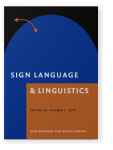Evie Malaia
List of John Benjamins publications for which Evie Malaia plays a role.
2024 The interaction of syntax, non-manuals, and prosodic cues as potential topic markers in Austrian Sign Language Sign Language & Linguistics: Online-First Articles | Article
Topic is often marked only by prosody across languages. In sign languages, prosody is expressed by features similar to those in speech: i.e., sign duration, velocity and amplitude of movement (cf. slope and range of pitch). Topicalized signs usually occur sentence-initially, are followed by a… read more
2018 A new technique for analyzing narrative prosodic effects in sign languages using motion capture technology Linguistic Foundations of Narration in Spoken and Sign Languages, Hübl, Annika and Markus Steinbach (eds.), pp. 15–40 | Chapter
The present paper addresses prosody at a sentence level analysis within short narratives, developing a novel method based on a combination of data. Our first objective, then, is to establish the validity of our new method by confirming the findings of previous reports on Phrase Final Lengthening.… read more
2012 What sign languages show: Neurobiological bases of visual phonology Towards a Biolinguistic Understanding of Grammar: Essays on interfaces, Di Sciullo, Anna Maria (ed.), pp. 265–276 | Article
The chapter presents analysis of the motion properties of the environment that humans use to parse natural scenes, and the kinematics of articulator (hand) motion in American and Croatian Sign Languages, asking whether the kinematic distinctions between linguistic categories in sign languages are… read more
2010 Early acquisition of sign language: What neuroimaging data tell us Sign Language & Linguistics 13:2, pp. 183–199 | Article
Early acquisition of a natural language, signed or spoken, has been shown to fundamentally impact both one’s ability to use the first language, and the ability to learn subsequent languages later in life (Mayberry 2007, 2009). This review summarizes a number of recent neuroimaging studies in order… read more


